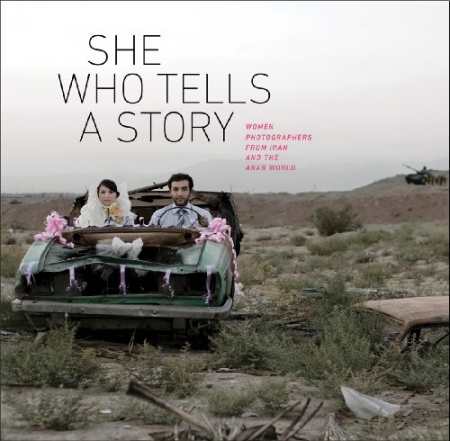She Who Tells a Story
Women Photographers from Iran and the Arab World
- 2013 INDIES Winner
- Editor's Choice Prize Nonfiction
Photographs from the nightmarish to the enchanting invite viewers to discover the richness of women’s creativity in the Arab world.
One stunning image can forever sear the brain with its truth. She Who Tells a Story: Women Photographers from Iran and the Arab World contains many such images: in a desert landscape scarred by war, a tank lurks menacingly as a young bride and her husband pose in a burned-out car, going nowhere; against a black backdrop, a mother with a child and her doll are gradually more heavily veiled until they are swallowed by darkness; a still life of fruit in a bowl reveals a hand grenade gently nestled against an orange.
Based on the Boston Museum of Fine Arts exhibition of the same name, She Who Tells a Story was put together by Kristen Gresh, the museum’s Estrellita and Yousef Karsh assistant curator of photographs, with a foreword by independent curator Michket Krifa. It features more than one hundred images by twelve of the exhibit’s photographers. Their work embraces subjects that range from the nightmarish to the purely enchanting, inviting viewers to discover the richness and depth of women’s creativity now being unleashed globally, and nowhere more vibrantly than in Iran and the Arab world.
Interest in art from the area, especially that of women, has been increasing since the Arab Spring uprisings began in Tunisia at the end of 2010. The revolution focused attention on issues of freedom of expression and gender equality in the Middle East and North Africa. Artists, both male and female, rode the winds of hoped-for freedom to explore the nature of the individual through their own lives. Women were the first to take hold of photography, once only a vehicle of reportage, and use it to explore the personal, the intimate, the unconscious—all that had been taboo. In this book, their powerful symbols of veiling and unveiling the body spill forth secrets, speaking volumes about the condition of women in the Arab world. Gresh states that Arab women are demanding “a singularity that is unusual in countries where the ‘I’ is almost taboo.” Moreover, they can no longer be seen as “other,” as their dreams, aspirations, and the very dailiness of their lives are shared by women everywhere.
Juxtaposing scenes of unimaginable horror and loss with those of a beauty at once delicate and powerful, the photographers dismantle the archetypal images that have defined Arab women, breaking down centuries-old walls built of mystery, myth, and misunderstanding. More than mere depictions of everyday reality in war-torn lands, this book documents their stands against the area’s gender prejudices. They honor the strength, resilience, and hope of women caught in the crossfire of war, women who are are bound by centuries of repression and awaiting the moment to burst forth into their full stature as human beings. By opening the eyes of the world to this vast potential, the exhibit and book have paved the way for this blossoming—in this lies much of the transformative power of images.
Reviewed by
Kristine Morris

